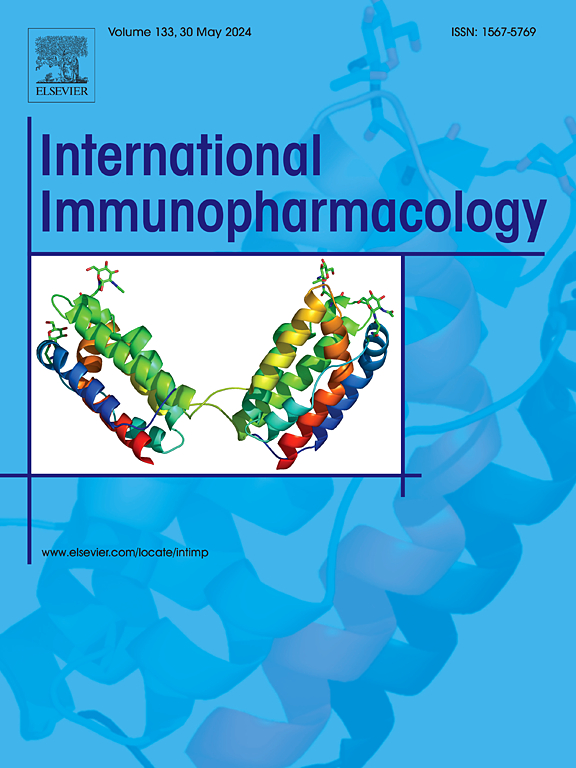SFAs通过TLR4促进神经酰胺的新生合成,并增强肝细胞脂毒性。
IF 4.8
2区 医学
Q2 IMMUNOLOGY
引用次数: 0
摘要
背景:非酒精性脂肪性肝炎(NASH)是非酒精性脂肪性肝病(NAFLD)的一种晚期表现,以肝细胞损伤、炎症和纤维化为特征。饱和脂肪酸(sfa)已成为肝细胞脂毒性和疾病进展的关键因素。toll样受体4 (TLR4)作为多种配体的哨兵,包括脂多糖(LPS)和内源性分子,如棕榈酸(PA)诱导的神经酰胺(CER)积累,促进肝细胞死亡。然而,TLR4调节神经酰胺代谢的复杂机制及其对sfa介导的肝毒性的协同作用仍不清楚。方法:通过棕榈油喂养和AAV2/8尾静脉注射建立肝脏特异性TLR4敲低小鼠NASH模型。通过组织学和生化评价小鼠的情况和肝损伤程度。采用液相色谱-质谱法(LC-MS)定量肝组织中的神经酰胺水平,为NASH机制提供见解。结果:po饲喂模型血清ALT、AST和肝脏TG水平升高,脂质积累增强,肝细胞损伤加剧。TLR4敲低肝脏质量和肝体重比,表明肝脏负担减轻。组织病理学评估显示,tlr4沉默的po喂养小鼠的肝脏脂肪变性明显改善,脂滴减少,炎症浸润减少。LC-MS分析显示,tlr4敲除的po喂养小鼠的长链神经酰胺(C14, C16, C20)明显减少。此外,MyD88、SPTLC1、SPTLC2和炎症标志物IL-1β、IL-6、TNF-α的表达明显减弱。结论:SFAs通过MyD88激活TLR4信号通路,促进神经酰胺从头合成,从而加剧肝细胞脂毒性并加速NASH进展。本文章由计算机程序翻译,如有差异,请以英文原文为准。
SFAs facilitates ceramide’s de novo synthesis via TLR4 and intensifies hepatocyte lipotoxicity
Background
Non-alcoholic steatohepatitis (NASH), an advanced manifestation of non-alcoholic fatty liver disease (NAFLD), is characterized by hepatocyte injury, inflammation, and fibrosis. Saturated fatty acids (SFAs) have emerged as key contributors to hepatocyte lipotoxicity and disease progression. Toll-like receptor 4 (TLR4) acts as a sentinel for diverse ligands, including lipopolysaccharide (LPS) and endogenous molecules like palmitic acid (PA)-induced ceramide (CER) accumulation, promoting hepatocyte demise. However, the intricate mechanisms underlying TLR4′s modulation of ceramide metabolism and their concerted effect on SFA-mediated hepatotoxicity remain elusive.
Methods
A NASH mouse model with liver-specific TLR4 knockdown was established through palm oil feeding and AAV2/8 tail vein injection. Histological and biochemical assessments were conducted to evaluate the mice’s condition and liver damage extent. Liquid chromatography-mass spectrometry (LC-MS) was employed to quantify ceramide levels in liver tissues, offering insights into NASH mechanisms.
Results
The PO-fed model exhibited elevated serum ALT, AST, and liver TG levels, enhancing lipid accumulation and hepatocellular damage. TLR4 knock-down reduced liver mass and the liver-to-body weight ratio, signifying a decreased hepatic burden. Histopathological evaluations revealed substantial improvement in hepatic steatosis in TLR4-silenced PO-fed mice, with diminished lipid droplets and inflammatory infiltrates. LC-MS analysis showed a marked decrease in long-chain ceramides (C14, C16, C20) in TLR4-knockdown PO-fed mice. Furthermore, expression of MyD88, SPTLC1, SPTLC2, and inflammatory markers IL-1β, IL-6, TNF-α were significantly attenuated.
Conclusion
SFAs activate the TLR4 signaling pathway via MyD88, fostering ceramide de novo synthesis, which exacerbates hepatocyte lipotoxicity and accelerates NASH progression.
求助全文
通过发布文献求助,成功后即可免费获取论文全文。
去求助
来源期刊
CiteScore
8.40
自引率
3.60%
发文量
935
审稿时长
53 days
期刊介绍:
International Immunopharmacology is the primary vehicle for the publication of original research papers pertinent to the overlapping areas of immunology, pharmacology, cytokine biology, immunotherapy, immunopathology and immunotoxicology. Review articles that encompass these subjects are also welcome.
The subject material appropriate for submission includes:
• Clinical studies employing immunotherapy of any type including the use of: bacterial and chemical agents; thymic hormones, interferon, lymphokines, etc., in transplantation and diseases such as cancer, immunodeficiency, chronic infection and allergic, inflammatory or autoimmune disorders.
• Studies on the mechanisms of action of these agents for specific parameters of immune competence as well as the overall clinical state.
• Pre-clinical animal studies and in vitro studies on mechanisms of action with immunopotentiators, immunomodulators, immunoadjuvants and other pharmacological agents active on cells participating in immune or allergic responses.
• Pharmacological compounds, microbial products and toxicological agents that affect the lymphoid system, and their mechanisms of action.
• Agents that activate genes or modify transcription and translation within the immune response.
• Substances activated, generated, or released through immunologic or related pathways that are pharmacologically active.
• Production, function and regulation of cytokines and their receptors.
• Classical pharmacological studies on the effects of chemokines and bioactive factors released during immunological reactions.

 求助内容:
求助内容: 应助结果提醒方式:
应助结果提醒方式:


